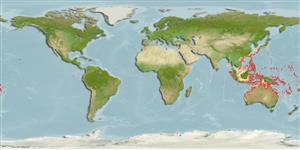Classification / Names
Common names from other countries
Main reference
Size / Weight / Age
Max length : 15.0 cm TL male/unsexed; (Ref. 2272)
Environment
Marine; reef-associated; depth range 9 - 55 m (Ref. 90102)
Climate / Range
Tropical, preferred ?
Distribution
Short description
Dorsal
spines
(total): 9;
Dorsal
soft rays
(total): 12;
Anal
spines: 3;
Anal
soft rays: 12;
Vertebrae: 25. Body whitish; a broad black stripe from snout through eye, ending in upper central part of caudal fin, this stripe separated by a narrow white band from a mid dorsal black stripe. Iris yellowish. Male with yellow border on the lower edge of lateral black stripe; basal blackish band of dorsal fin tinged with red instead of yellow; anal fin darker yellow; caudal tinged with light red basally on lobe instead of bluish white. 6 branchiostegal rays. Fin spines pungent.
IUCN Red List Status (Ref. 115185)
Threat to humans
Harmless
Human uses
Aquarium: commercial
More information
ReferencesAquacultureAquaculture profileStrainsGeneticsAllele frequenciesHeritabilityDiseasesProcessingMass conversion
Tools
Special reports
Download XML
Internet sources
Estimates of some properties based on models
Phylogenetic diversity index
PD50 = 0.5000 many relatives (e.g. carps) 0.5 - 2.0 few relatives (e.g. lungfishes)
Trophic Level
3.3 ±0.3 se; Based on size and trophs of closest relatives
Resilience
High, minimum population doubling time less than 15 months (Preliminary K or Fecundity.)
Vulnerability
Low vulnerability (24 of 100)
Price category
